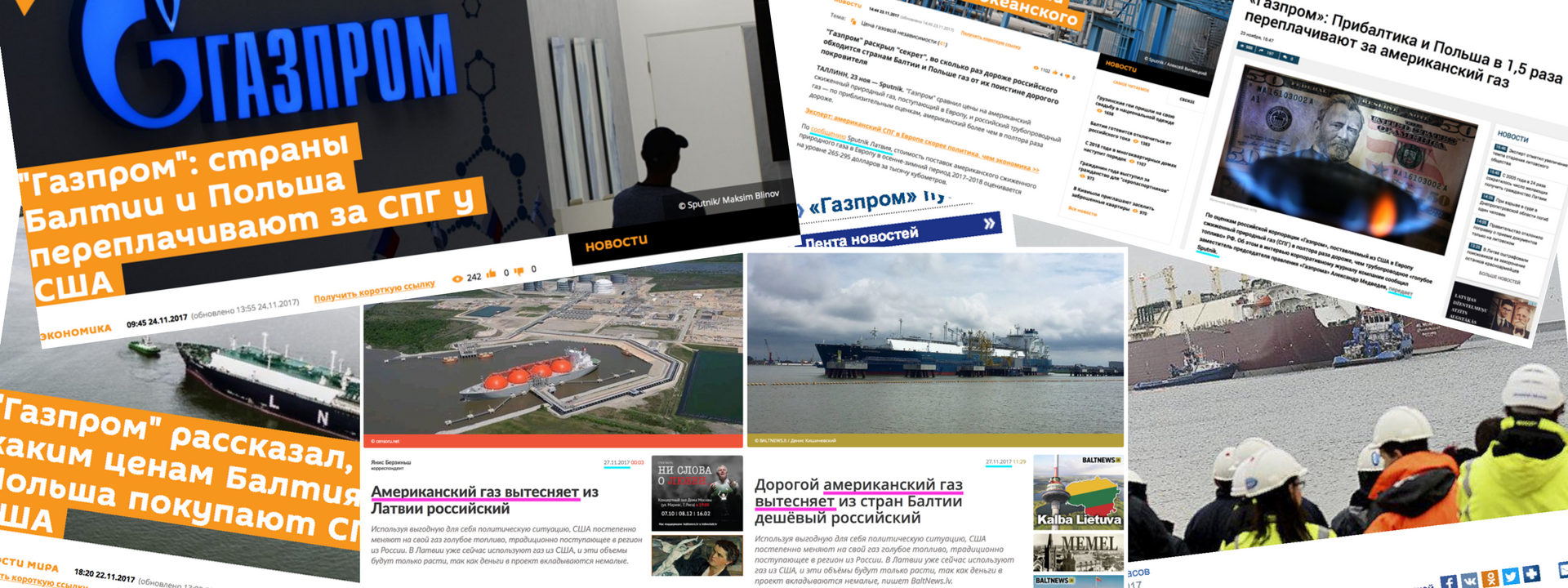#BalticBrief: Hot Air Over Natural Gas
Kremlin-backed media in the Baltics deploy on Poland’s liquefied natural gas imports from the United States
#BalticBrief: Hot Air Over Natural Gas

Kremlin-backed media in the Baltics deploy on Poland’s liquefied natural gas imports from the United States

Russia was historically the main natural gas supplier to Europe since the Soviet times. Eastern European countries, including the Baltic states heavily depend on Russian natural gas supplies, often facing unfair gas pricing. In 2016, Russia accounted for 39.7% of all natural gas imported in European Union member states. Norway provided 34.1% of the natural gas last year.
The situation is changing. In 2014 Lithuania opened its own Liquefied Natural Gas (LNG) terminal, which allows natural gas shipments from Norway and, most recently, from the United States on more flexible terms, in comparison with pipeline gas from Russia. Poland opened its LNG terminal in 2015.
In 2017 Poland and Lithuania began to receive LNG from the private companies based in United States, as well. On April 27, 2017, Poland signed a deal to buy LNG from U.S. company Cheniere and received first shipments on June 8.
Two months later, Lithuania also bought LNG from a U.S.-based company and received the first shipment on August 21. Later, on July 12, Lithuania signed a deal for another LNG delivery form U.S. Most recently, on November 21, Polish state-run gas firm PGNiG signed its first mid-term deal to receive nine LNG shipments in 2018–2022.
Poland also announced that it will not extend its long-term contract with Russia’s energy company Gazprom. The changing situation was addressed by Russian state-funded media in the Baltic states.
Targeting the Baltic states
Following the Polish announcement about the mid-term contract for LNG supplies from the United States on November 22, Sputnik Latvia published a story on Gazprom, which compared American LNG prices with the Russian alternative. The article suggested that while Gazprom is offering one thousand square meters of natural gas for 190 USD, the U.S.-based companies are offering the same amount for 265–295 USD, which is 1.5 times more expensive.

A day later on November 23, the story was republished on Sputnik Estonia and another pro-Kremlin media outlet called Rubaltic.ru. The topic was also addressed by Russian media outlet in Latvia Vesti.lv.

The original source cited in the reporting was an interview in Gazprom’s corporate magazine with the Vice Chairman of Gazprom Andrey Medvedev.

Sputnik Lithuania published the article about the Gazprom’s price comparison on November 24, two days after the story was first published in Latvia.

Curiously, Sputnik Lithuania did not tag the story under any specific topic, while Sputnik Latvia and Sputnik Estonia did.

The Sputnik Latvia tagged the story under a topic “On a blue gas”, whereas the Sputnik Estonia named the topic “The price of gas independence”. Sputnik Latvia produced 1.6 times more stories under the topic — 67 versus 41 respectively.
Four days later, Sputnik’s little brother Baltnews.lv republished Sputnik Latvia story and titled it: “American gas will push out Russian gas from Latvia”. On the same day, Baltnews.lt republished the story with a slightly different title: “The expensive American gas will push out the cheap Russian gas from the Baltic states”.

Overall, the story about Russian and U.S. gas prices circulated in the pro-Kremlin media in the Baltic states for five days and it was not the only story on Poland’s and Lithuania’s gas imports.
On November 23, Sputnik Latvia published another story about the expensive American gas that is going to be offered to Latvian tax payers. On the same day Sputnik Estonia also published an article titled “An expert: American LNG in Europe is rather politics than economics”. Sputnik Lithuania published two additional articles about the topic on November 23. One was based on Rubaltic.ru interview with the Head of Russian National Energy Security Fund Konstantin Simonov. Sputnik Lithuania titled its article “Simonov: even the court did not support Lithuania in the lawsuit against Gazprom”. The other article Sputnik Lithuania published was Lithuanian energy policy analysis by Boris Marcinkevich, an editor in chief of Russian online magazine Geoenergetika.ru. The same analysis was republished on Belarussian version of pro-Kremlin opinion blog IMHOClub and Russian media Rambler.
Curiously, just a few Russian media outlets, in particular Russian business media outlet Komersant.ru and Russian news agency RNS, reported the price comparison “Gazprom” produced. On November 22, RIA Novosti published an analytical article about the reasons Poland is buying LNG from the United States, in which it mentioned the price Poland is paying for LNG is higher than Russia is offering.
Gas prices for households in the Baltic states
Although the story about LNG prices offered by U.S.-based companies for Poland and Lithuania suggests that both countries are overpaying, the prices for the households went down since Lithuania opened its LNG terminal in Klaipeda in December 2014.

Gas price for households in Poland also decreased a year after Poland opened its LNG terminal in October 2015.

On November 30, both Sputnik Lithuania and Baltnews.lt reported for households in Lithuania decreasing gas prices starting January 2018.
Conclusion
Pro-Kremlin media in the Baltic states paid close attention to how natural gas markets develop in the region. The Kremlin-backed or Kremlin-aligned outlets do not miss an opportunity, and sometimes create opportunities, to point out economic disadvantage of buying LNG from companies in United States. However, the economic evidence suggests that natural gas prices for households in Lithuania and Poland are going down.
Follow along for more in-depth analysis from our #DigitalSherlocks.

